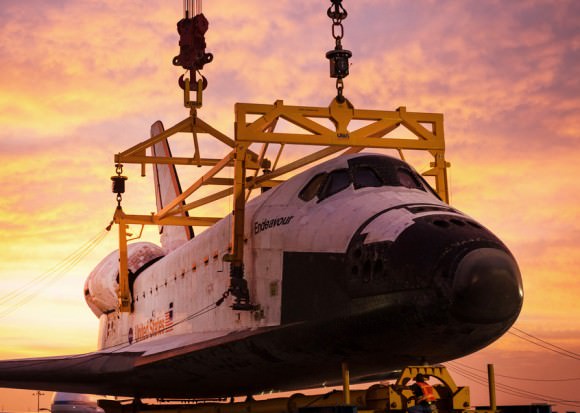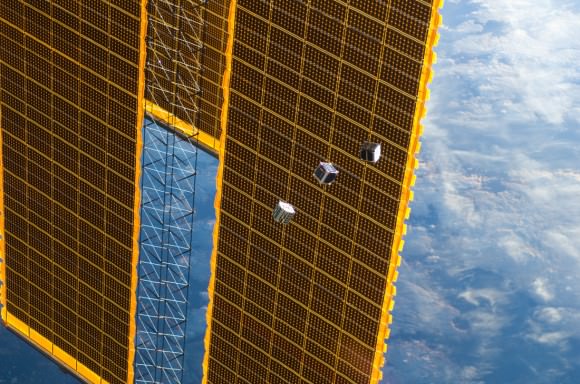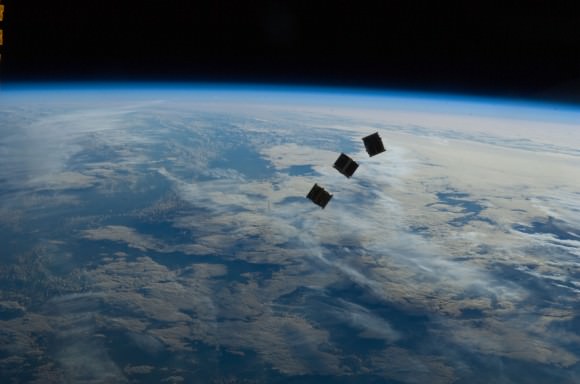For two days, from October 12 to 13, the shuttle Endeavour will be transported along 12 miles of road on the final leg of its journey to the California Science Center. During that time the orbiter will be the most publicly exposed as it’s ever been, a national treasure on the streets of LA. While this will of course be a well-orchestrated undertaking with the security of not only Endeavour but citizens and spectators being of utmost priority, one might be prompted to speculate: what if someone tried to steal the space shuttle?
And that one, in this instance, was Jalopnik.com‘s Jason Torchinsky. In his latest article, Jason describes in detail a method for snatching a spaceship — and a rather dramatic one at that, worthy of a Bondian supervillian (and requiring a similarly cinematic amount of funds.) However nefarious, fictitious, and unlikely, it’s nevertheless intriguing.
Surreal Photos: CubeSats Launched from the Space Station
Five tiny CubeSats were deployed from the International Space Station on Thursday and astronaut Chris Hadfield called the image above “surreal” on Twitter. And rightly so, as they look like a cross between Star Wars training droids and mini Borg Cubes from Star Trek. The Cubesats measure about 10 centimeters (4 inches) on a side and each will conduct a range of scientific missions, ranging from Earth observation and photography to technology demonstrations to sending LED pulses in Morse Code (which should be visible from Earth) to test out a potential type of optical communication system.
These are low-cost satellites that could be the wave of the future to enable students and smaller companies to send equipment into space. If you’re worried about these tiny sats creating more space junk, Hadfield assured that since they are very light and in such a low orbit, the Cubesat orbits will decay within a few months.
The Rubic-cube-sized Cubesats were deployed from the new Japanese Small Satellite Orbital Deployer that was brought to the space station in July by the Japanese HTV cargo carrier.
The Japanese FITSAT-1 will investigate the potential for new kinds of optical communication by transmitting text information to the ground via pulses of light set to Morse code. The message was originally intended to be seen just in Japan, but people around the world have asked for the satellite to communicate when it overflies them, said Takushi Tanaka, professor at The Fukuoka Institute of Technology.
Observers, ideally with binoculars, will be able to see flashes of light — green in the northern hemisphere, where people will see the “front” of the satellite, and red in the southern hemisphere, where the “back” will be visible.
The message it will send is “Hi this is Niwaka Japan.” Niwaka is the satellite’s nickname and reflects a play on words in the local dialect of southwestern Japan, according to an article on Discovery Space. To see the Morse Code message, the Cubesat will be near the ISS, so find out when you can see the ISS from NASA or Heaven’s Above. Find out more about the FITSAT at this website.
The other Cubesats include NASA’s TechEdSat which carries a ham radio transmitter and was developed by a group of student interns from San Jose State University (SJSU) in California with mentoring and support from staff at NASA’s Ames Research Center.
“TechEdSat will evaluate plug-and-play technologies, like avionics designed by commercial providers, and will allow a group of very talented aerospace engineering students from San Jose State University to experience a spaceflight project from formulation through decommission of a small spacecraft,” said Ames Director S. Pete Worden.
The other Cubesats include RAIKO, which will do photography from space, We Wish, an infrared camera for environmental studies, and and the F-1 Vietnam Student CubeSat which has an on-board camera for Earth observation.
See more cool-looking images and video of the deployement below (all images credit the Expedition 32 crew from the ISS/NASA):



No comments:
Post a Comment